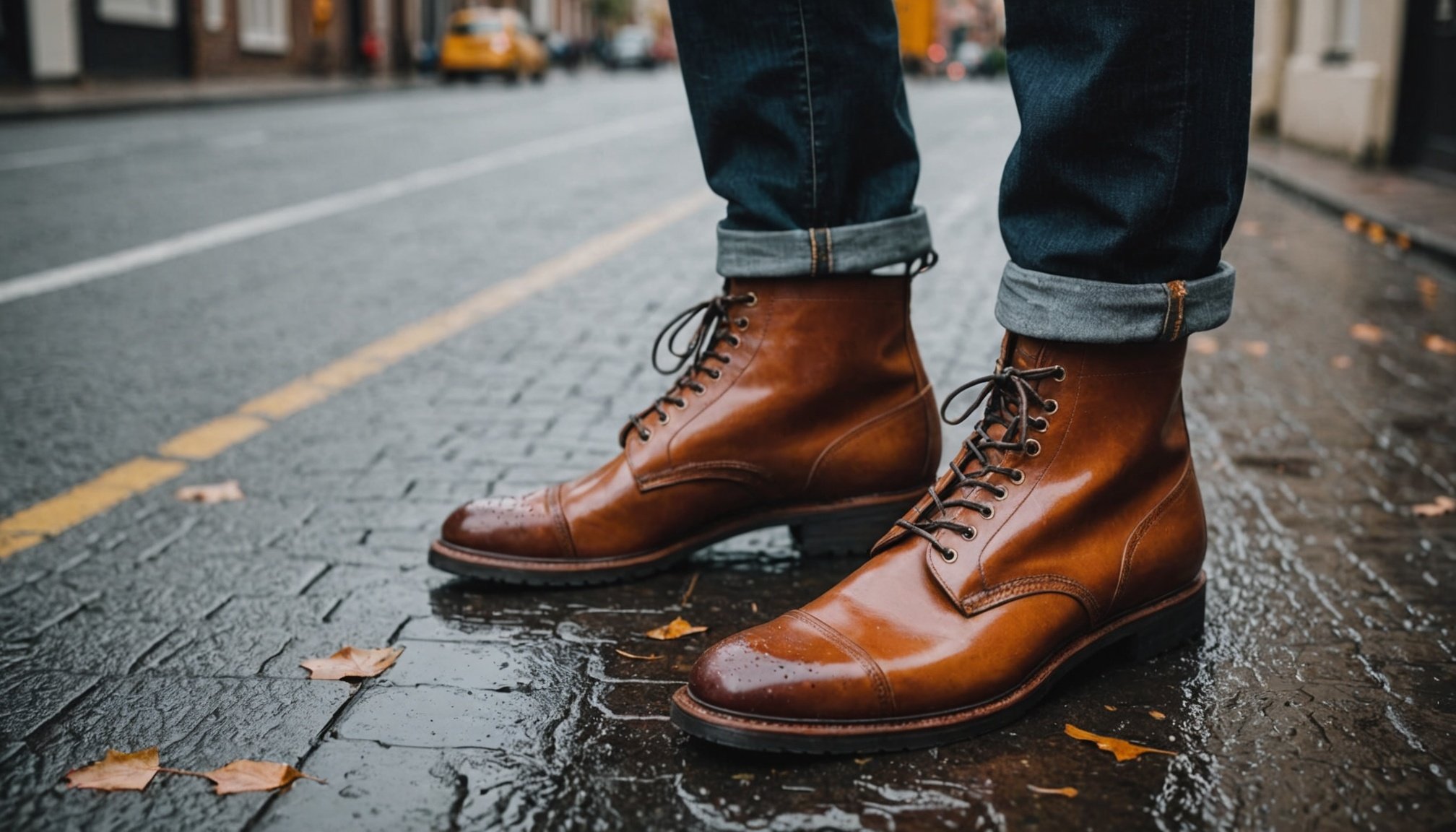Understanding Leather and Its Vulnerability to Moisture
Leather, revered for its durability and aesthetic appeal, derives its natural properties from animal hides that undergo a tanning process. These inherent characteristics, including flexibility and strength, vary across leather types such as full-grain, corrected-grain, and suede. Each type offers a different experience in terms of texture, resilience, and moisture absorption.
Moisture poses a significant threat to leather. When exposed, it can result in undesirable changes across leather varieties. Full-grain leather, the most robust type, can still warp or lose shape with excess moisture, whereas more delicate types, like suede, may show immediate signs of damage such as discoloration or texture alteration. Recognizing these signs of moisture damage is essential. Common indicators include dark spots, musty odors, and a stiff, warped surface on leather footwear.
Also read : Conquer Winter Hair Static in the UK: Your Ultimate Guide to Effective Solutions
Proper leather care is imperative to prevent moisture damage. Understanding each leather type’s vulnerabilities enables tailored care approaches. This ensures your leather not only endures but also retains its quality and appearance over time, safeguarding your investment in both style and utility.
Importance of Regular Maintenance
Regular leather maintenance is essential for preserving the quality and durability of your footwear. A consistent cleaning routine not only maintains the appearance but also extends the lifespan of leather shoes. In the UK, where the climate often presents challenges with rain and humidity, these practices become even more crucial.
Topic to read : Chic DIY Face Masks: Elevate Your Style with Fashionable Fabric Choices!
Firstly, a regular cleaning routine involves wiping down your leather shoes with a damp cloth to remove dirt and dust particles. This basic step prevents contaminants from embedding into the material, which could lead to moisture absorption.
For effective results, consider using mild soap mixed with water for tough dirt. It’s important to avoid soaking leather, as excess moisture can deteriorate it.
Moreover, conditioning leather is a critical step to maintain suppleness and strength. Conditioning helps replace natural oils lost due to environmental exposure, thus preventing cracks and tears.
Use leather-specific conditioners sparingly but regularly for best results. These solutions provide a protective layer, promoting longevity and keeping your shoes looking as good as new. By adhering to simple care tips, you safeguard your footwear from unnecessary damage, ensuring it not only endures but remains comfortable and stylish.
Effective Cleaning Techniques
Preserving leather footwear requires mastering cleaning leather footwear techniques to ensure both longevity and appearance. Selecting the proper supplies is as critical as the cleaning method itself.
Basic Cleaning Steps
Start by removing loose dirt with a soft brush or cloth. It’s crucial to use mildly damp cloths to avoid over-saturating the leather. Properly cleaning leather footwear involves using circular motions to prevent streaks.
Advanced Cleaning Techniques
For stubborn stains, advanced techniques might be necessary. Apply a small amount of saddle soap or specialized cleaner to a damp cloth. Gently rub it over the stained area until it lifts. However, ensure that the cleaner is suitable for your leather type to prevent damage.
Recommended Products
Regarding cleaning methods, some products excel in the UK climate. A leather cleaner with conditioning properties will protect against rain-induced moisture damage. Certain brands offer formulations that effectively clean while maintaining leather’s suppleness. Select a product that offers both cleaning and conditioning benefits to streamline your routine.
Waterproofing Leather Footwear
Ensuring your leather footwear remains waterproof is crucial for maintaining its durability and appearance, especially in areas with unpredictable weather. Various waterproofing methods cater to different needs and leather types. Protective sprays are among the most common choices for safeguarding against moisture damage. These sprays create a barrier that repels water, preventing it from seeping into the leather and causing damage. Opt for products specifically designed for leather types to maximize effectiveness.
Additionally, treatment products like waxes and creams offer robust protection. They nourish the leather while forming a protective layer against the elements. The wax application involves rubbing the product onto the leather gently, ensuring even coverage for optimal protection.
Reapplication frequency depends on footwear usage. For frequently worn shoes, applying waterproofing products every few weeks is advisable. In contrast, less-used footwear may require treatment every few months. Crucially, always follow the product instructions for best results.
By selecting appropriate waterproofing solutions and adhering to a regular treatment schedule, you can effectively protect your leather footwear from water-related damage, preserving their quality and extending their lifespan.
Proper Storage of Leather Footwear
Properly storing leather shoes is essential to maintain their shape and quality, especially in humid climates. When dealing with humidity, the right preservation methods can prevent unwanted issues like mold and mildew. Always ensure your storage area is dry and has good ventilation. Lack of airflow can cause moisture buildup, leading to unpleasant odors and biological growth.
One effective method to preserve the shape and quality of leather footwear is using shoe trees. These devices help maintain the shoe’s contour and absorb excess moisture. Investing in quality cedar shoe trees can also impart a pleasant scent to your shoes. Meanwhile, dust bags serve as an extra layer of protection, preventing dust accumulation while allowing some air circulation.
Finally, avoid piling shoes on top of each other to prevent creasing or warping of the leather. Allocate enough space to let them “breathe” and ensure they’re not exposed to direct sunlight or extreme temperatures. By incorporating these shoe care practices, you enhance the longevity and appearance of your leather footwear, ultimately protecting your investment.
Common Mistakes in Leather Care
Navigating the complexities of leather care can be daunting, often leading to common mistakes that damage footwear. One frequent error is failing to recognize the distinct needs of different leather types. For instance, using a one-size-fits-all method may harm delicate leather, like suede. Each type demands tailored products and techniques to maintain its quality.
Misunderstandings also arise around the application of conditioning products. Over-conditioning or using inappropriate conditioners can make leather sticky or brittle. Preferably, use leather-specific conditioning sparingly and follow manufacturer guidelines. Equally, avoid applying conditioners directly after cleaning before the leather fully dries, as this can trap moisture and result in lasting damage.
Improper storage situations, such as storing leather in damp environments without adequate ventilation, can cause moisture buildup, leading to mold and mildew. Always ensure shoes are stored in dry areas with good airflow.
Lastly, using abrasive brushes or harsh chemicals for cleaning is a critical mistake. These tools can strip the protective layer, affecting the footwear’s lifespan and appearance. To prevent such pitfalls, always invest in proper supplies and commit to best practices.
Additional Resources
Accessing comprehensive leather care guides can significantly enhance your care routine. Websites dedicated to leather maintenance offer step-by-step advice for diverse leather types. These guides emphasize tailored approaches, reinforcing the importance of specialized care tips for each leather variety.
Online Resources for Leather Care
Various platforms provide free, insightful articles focusing on regional challenges like the UK’s damp climate. Users can learn cleaning methods, waterproofing techniques, and storage solutions to extend the life of their footwear.
Community Tips and Tricks
Engaging with community forums can also provide practical insights. From sharing unexpected uses of household items to personalized solutions, these forums foster a space for exchanging care strategies. Reading firsthand experiences equips you with diverse solutions for moisture damage and other common issues.
Recommended Retailers
Selecting quality products ensures effective leather care. Recommended retailers offer an assortment of cleaning supplies, conditioners, and protective sprays tailored to UK-specific needs. Investing in proven treatment products helps manage leather’s vulnerabilities and maintain its texture over time. Explore these resources to enhance your leather footwear care strategy with confidence.





